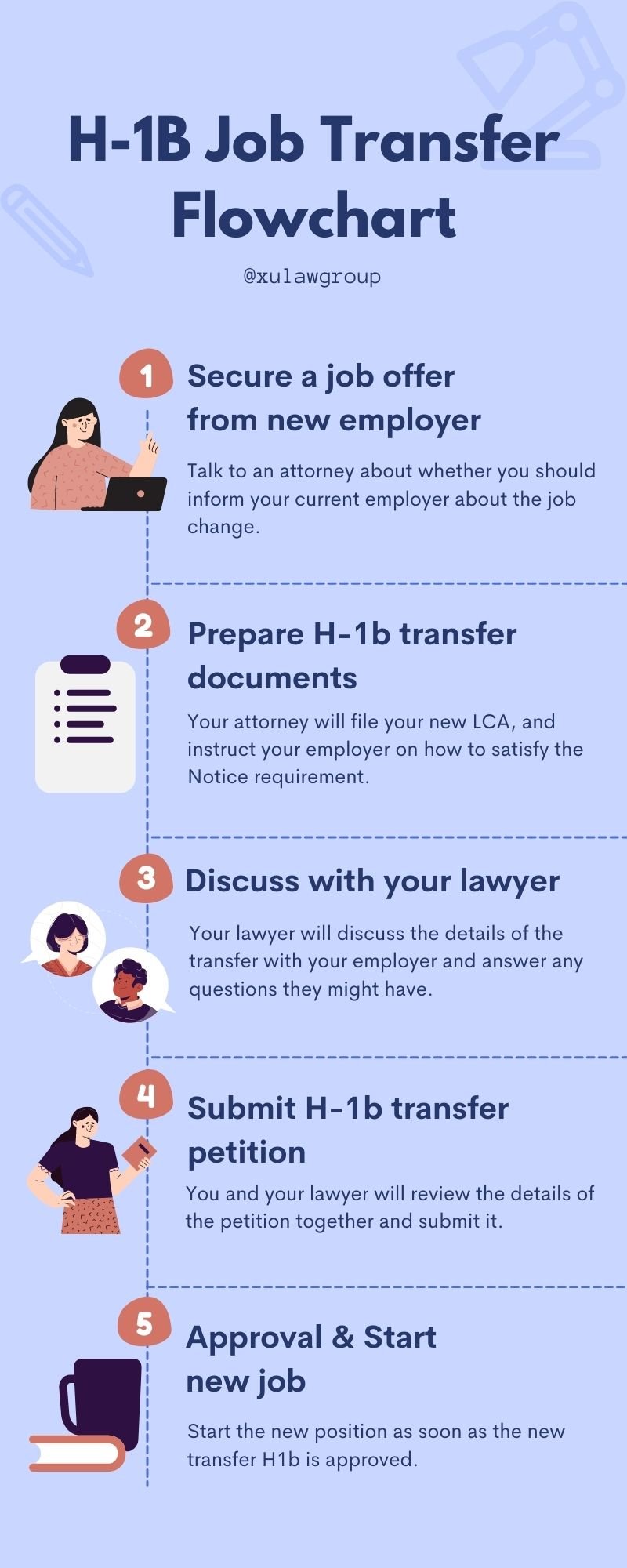The Ultimate Guide to H-1B Job Transfer
The H1-B program allows employers to hire nonimmigrant foreign workers in specialty occupations on a temporary basis. Typically, the employee is able to work for an employer on an H1-B visa for up to six years. If the employee later decides to find another employer, H1B visa holders can change their employer while in the US under a process which is known as the H1B transfer. In order to be eligible for an H1B transfer, the employee must have a valid H1B visa before initiating the transfer process.
The process of transferring your H1B visa to another employer can be summarized into the following few steps:
Applying for an H1B transfer is similar to applying for an initial H1B visa, with the exception that no visa cap applies to H1B transfers. The applicant does not need to go through the lottery process. For the H1B holder, the first step is to receive a job offer from the prospective new employer. The process cannot begin without this offer. The new employer must also get a Labor Condition Application (LCA) certification from the U.S Department of Labor. This document certifies the U.S employer will treat foreign workers fairly by paying a full wage and providing a good work environment.
Once the new employer has the LCA certification, they must also file form I-129. This form serves as permission to hire foreign workers. USCIS processes the form and send a receipt number to both the employer and employee. Once a receipt number is received, the employee can start working for the new employer. The USCIS has confirmed that a FedEx or UPS confirmation is sufficient to confirm “receipt,” so it is not necessary to wait for the official USCIS receipt notice to be issued, but some applicants prefer to wait the 1-2 weeks it takes to receive this receipt notice.
When the petition is approved, both parties receive the I-797 form. This form proves that the employee is authorized to work in the U.S for that specific employer. The employer also has to file Form I-9 or the Employment Eligibility Verification form to USCIS.
In addition to the forms the employer is required to file, the employee must provide the following documents to USCIS:
· Copy of the offer letter from employer
· Copy of passport
· Copy of current H1B visa (visa stamp)
· Copy of Form I-797
· Copy of Form I-94
· Copy of social security card
· Copy of qualifications (degrees and certificates)
· Recent pay stubs (2 or 3 previous pay stubs)
· Copy of tax returns (if applicable)
· Updated resume
Since the employee already has a valid H1B visa, he or she will not need to file a DS-160 Form. The employee only has to submit the above documents to USCIS.
Typically, an H1B transfer takes 1 to 4 months for regular processing and 15 to 30 days for premium processing. The fee for premium process is around $1,225. Interested parties can check approximate current processing times on the USCIS website.
Sometimes, USCIS will deny an H1B visa transfer, but, the USCIS will send a Request for Evidence (RFE) if USCIS needs more documents to make a decision. Most often, RFEs are issued in the following cases:
· Educational Qualifications – in this case, the employee needs to prove that they have the qualifications they claim to have. Documents include additional diplomas and certificates, for example.
· Determination of a specialty occupation – the employee has to prove that they fit the definition of a specialty education.
· Proof of employer/employee relationship – both parties need to prove to USCIS that they have a valid working relationship and that the job is legitimate.
· Financial documents – the employer has to prove that they can afford to hire a new employee and that they can pay them.
After the additional RFE documents are submitted, USCIS will make a decision. If denied, USCIS will provide a reason as to why. Some of the most common reasons for denial are:
· Not paying the correct fees – USCIS fees can change, so it’s possible to submit insufficient fees if the applicant does not check.
· Employee lacks proof of specialty occupation – if the applicant cannot prove he or she has the qualifications for the position, the transfer will be denied.
· Failing to prove the employer / employee relationship – USCIS wants proof that there is an valid employment relationship. It is important to submit all documents, especially the work contract. The contract should be specific enough, detailing job description and responsibilities, salary, as well as location of work.
· The employer is unable to pay the employee - to avoid this, the employer should submit all financial and tax documents that are required and make sure that there is no reason for USCIS to doubt their financial situation is insufficient to hire foreign workers.
· The documents were not delivered to the right entity.
· The documents were not filled out correctly.
· The applicant committed a crime or violated immigration laws.
If the H1B transfer is denied, the applicant can reapply, but it is important to gather the correct supporting documents and fulfill the necessary requirements to get the transfer approved as expeditiously as possible.
Step One: Secure a New Job Offer
Step Two: Prepare H1B Transfer Documents
The first document we will prepare for the new H1B employer is the labor condition application (LCA). The LCA, Form 9035 is a document that a prospective H1B employer files when it seeks to employ an H1B specialty worker. The LCA includes information about the job details, locations, and required degrees, the wage paid to the H1B specialty worker, and some general information about the sponsor employer. It generally takes 7 days for the U.S. Department of Labor to certify an LCA. A certified LCA is required in any H1B petition. After the LCA is certified, we will include this in the H1b transfer application.
Step Three: Discuss any nuances with your attorney
Step Four: Submitting the Transfer Petition
Step Five: H1B Approval & Start New Job


